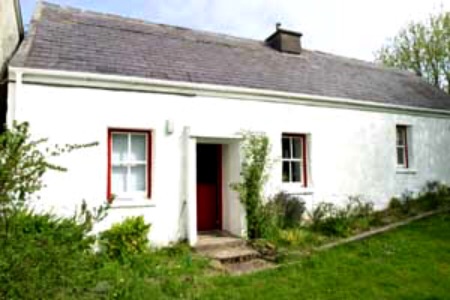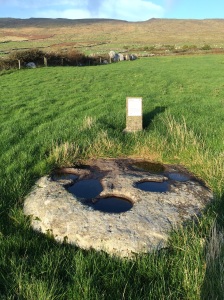
Looking out to Smerwick Harbour from the “beehive” ruins up the road
After our U.S. odyssey we let our inner Celt have her Banshee head. She’d been weeping and wailing for Ireland the whole time since we’d left the Dingle Peninsular six weeks before, having spent only a single intriguing day and a night there. So we went back and proceeded to self-cater in a renovated 200 year-old Rambling House in
Kilmalkedar, a hamlet overlooking Smerwick harbour, close by Dingle, the main town on the peninsular.
We have rambling houses to thank for ensuring the safe passage of traditional folklore, stories and music from generation to generation, as hearty places where people congregated for gossip, storytelling – and doubtless the odd song and dance late into the night.
I should also acknowledge that my recent introduction to a publication called “The House on an Irish Hillside”, by Felicity Hayes-McCoy had amplified the return-to-Dingle call we were hearing. Her rich writing focuses on the way of life on the spectacular Dingle Peninsular, the history, myths and anthropology of the Gaeltacht (Irish speaking) people. This book has reinforced my fascination with this spectacular part of the world.
Dingle, long an isolated region, retains much of its tradition and, to a large degree, has resisted economic and cultural change. The Irish name for the peninsular is Corca Dhuibhne, pronounced “Kirka Gwinnie” and is the westernmost point of Ireland, arguably of Europe. Legend has it that the next closest parish is Boston! The region is one of Ireland’s growing number of Gaeltachts, meaning areas where English takes a very humble back seat to Irish. The hundreds of archaeological sites on the peninsula testifies to its rich cultural past.
The main windows of our house looked out over Smerwick Harbour and further to one of the Blaskett Islands, Inishtooskert, fondly known as the ‘Sleeping Giant’ or ‘The Deadman’. Immediately next door we had the Kilmekadar church and cemetery, a Norman centre for worship and burial in the twelfth century.
There is an Ogham stone dominating the graveyard (see previous Irish post) which has a small hole at the top where important agreements were made and said to be sealed by respective parties placing a finger through each side of the hole. The bulk of Ogham Stones date to the 5th and 6th centuries and are an Early Medieval form of alphabet or cypher, sometimes known as the “Celtic Tree Alphabet”.
During our stay I managed to read four books about the Blaskett Islanders and their relationship with mainland Ireland. On our initial Dingle stay, we had visited the Blaskett Centre where my fascination with Blaskett Islanders began. Their stories are fascinating, unique, and to be celebrated despite the hardships. The islands lacked adequately fortified and maintained infrastructure for sea access, which meant isolation and food shortages during the bad weather months when the islanders were cut off for long periods. Sadly, the persistent emigration of its young people brought an ultimate communal decline and in 1953, when only 22 inhabitants remained, the Islands were abandoned.
To-day, weather permitting, tourists can day-trip to The Great Blaskett, and during the warmer months when the hostel is open for business, stay in what was once the home of Pieg Sayers, one of the greatest story tellers of recent times.
As the most prominent writer amongst the Blaskett Islanders, Pieg Sayer’s book was part of the Irish school curriculum for many years.
Ironically and tragically however, the 1930’s church/state-approved version of Pieg’s original text, purged so much of the keen colour, humour and blinding honesty which rendered her insights so delicious, that it was ruined for generations of school children, who were thus force-fed a hard, dry, bland chew.
We managed to borrow the 1970 David Lean movie, Ryan’s Daughter, from the local library and feasted on its superb cinematography of the haunting natural beauty of the area we were sitting in!!
The sheer majesty of the landscapes and panoramas that had attracted the film-makers, then promptly ushered the start of a tourist stream to the Dingle Peninsula that to-day not only keeps the town well-watered throughout the year, but floods it all summer until well into autumn.
Finally, we are happy to hear that Muireann’s new cooking school has launched and is very busy.

Rambling Traditions flourish…Mick Wallace, Wexford Independent Member of Irish Parliament, The Dail, in Question Time.
On our previous stay, our lovely B&B host Muireann, who had taken meticulous care of our interests in local fare and fun, was immersed in preparations to open a cooking school in Dingle.There was much work to do pre-opening, and she was excited and busy. Before returning to Dingle we read a piece from the Irish Examiner, the writer Tommy Barker wrote a big column praising the town’s food focus,”Chef Martin Bealin of the town’s Michelin-recognised Global Village Restaurant. Bealin, along with Mark Murphy of Tralee IT, and Muireann Nic Giolla Ruaidh, are setting up the Dingle Cookery School”.









Envious to say the least its its usual tropical weather up here first rain for months can’t really call it a wet season Ireland gets into your soul does it not ? ?I’ll have to watch ryans daughter yet again have you been to Achill sound? Its lovely I once went fishing for mackerel in a curragh armed with line and bread for bait caught lots then took em home and cooked em yum.love your posts xxxx
Thanx Rose, no we didn’t get to Achill. Maybe next time….for a next time there will be,..or two…or three…Glad the Wet has come to you. It’s always such a relief. Love to you and Sal, xx
Impressive photography ….irish tourist board could do well to employ you …what with the words and now the pictures!! Glad that ireland got into your souls….hugs Beth
Hi Beth, you big Irish Flatterer! Keep it coming…It’ll get you everywhere,…plus help us to keep our end up. Love to you and Susan
Green with the irishest of envies!!
great comment! Deserves a nice big bunch of shamrocks on the tarp’a t’ marnintoyoo xxxx
Thanks Annie & Janet -great read &brings back lots of good memories of our travels in Ireland in May last year.Happy travels ,love Jennyxxx
Hi Jenny, and lovely to hear from you. I suppose you and Pats are knee-deep in planning where next? Hope you are both well and the road you choose rise to meet you! XX